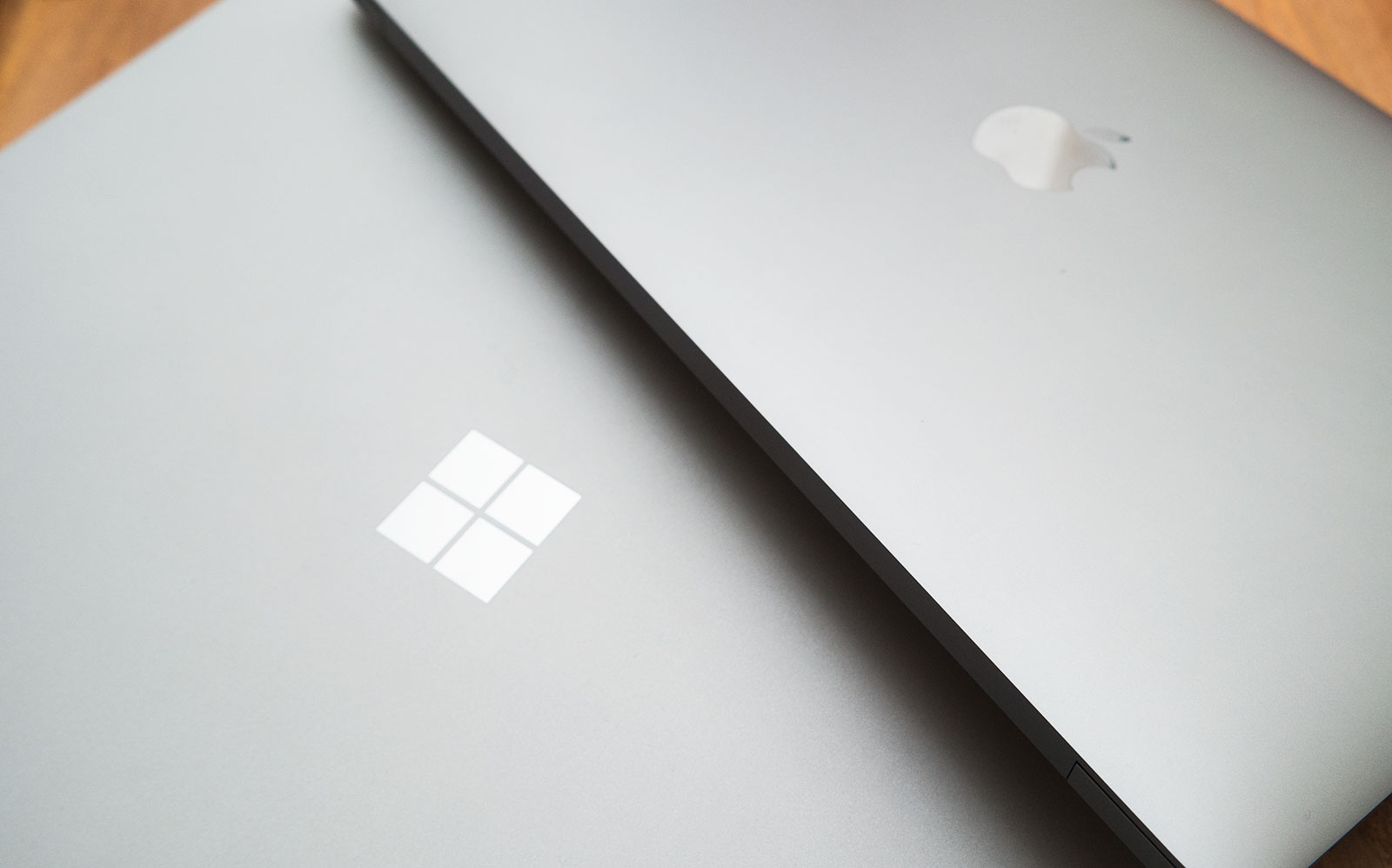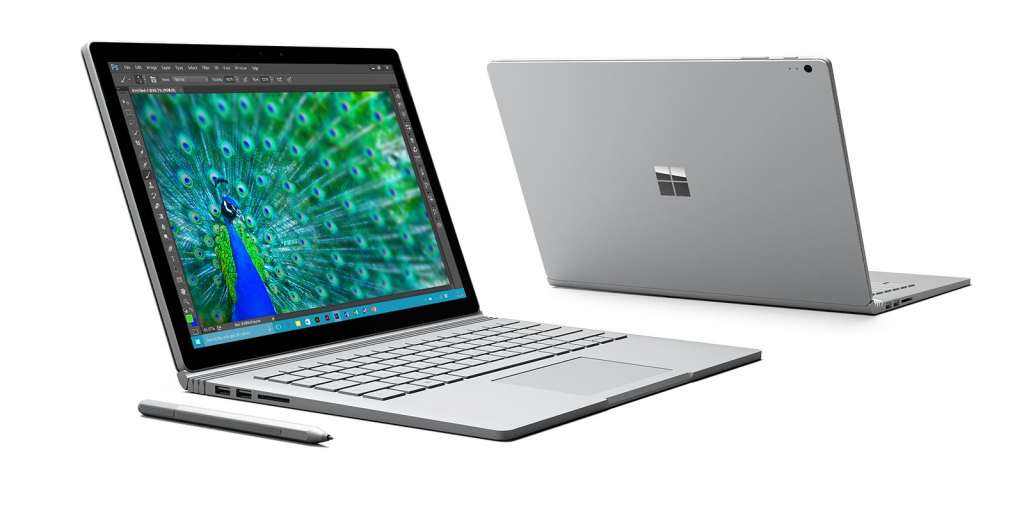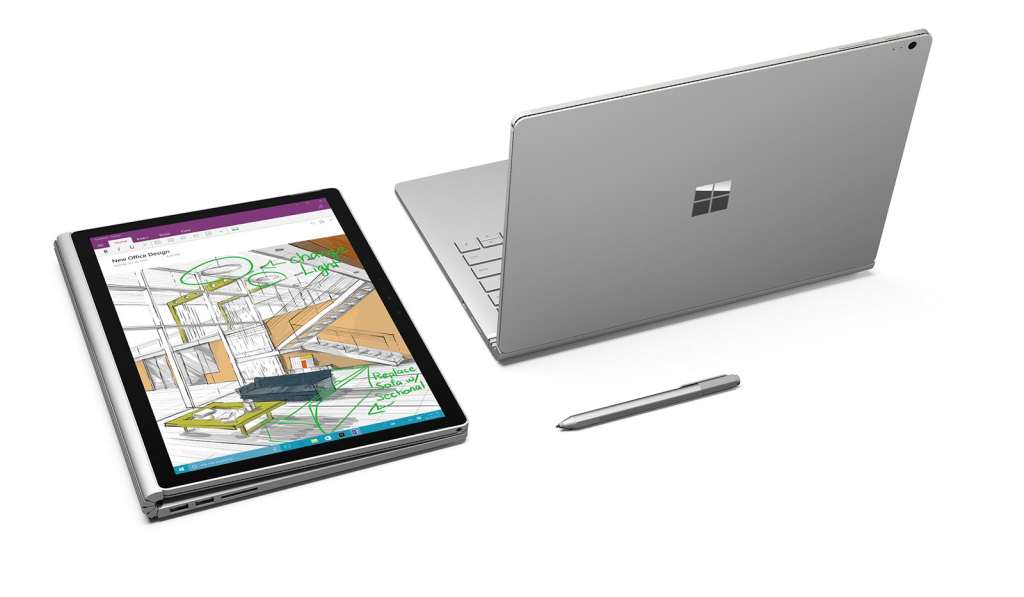Now that the new generation of the MacBook is out, a new battleground is emerging, as creatives and professionals compare Microsoft to Apple, so who offers the superior machine?
A few weeks ago in an office I’m currently doing a day job in, I heard a few people talking about the announcements by Apple and Microsoft.
Both had been made in the same week, with Microsoft talking about its additions to the Surface line-up first, followed by a complete design and spec overhaul from Apple shortly after, and it’s pretty clear to say that both were very, very different.
The Surface refresh appears to have ignited the design world on fire, particularly thanks to that Surface Studio, an all-in-one that appears to take the Microsoft’s detachable Surface Book concept and plonk all its neato parts under a massive touchscreen, providing a fast and fairly innovative touchscreen computer that designers can really get into with the added bonus of a pen that comes with the system.
On the other hand, Apple’s update to the MacBook Pro is relatively modest by comparison, making the design thinner, switching out the specs, brightening the screen, and changing out the ports, with the top models also including a new touchscreen that replaces some keyboard keys.
In many ways, it’s kind of what you’d expect to be the evolution of a Mac, because Apple already has touchscreen computers: they’re called the iPad and iPhone, and it doesn’t see the real computers — the laptop and desktop — sharing the same space.
But not everyone agrees, and in the office I was in, I could hear the comments.
“It really feels like Apple is being left behind,” one person said.
“It’s a totally different company without Steve Jobs,” I heard shortly after. “The Surface looks so much better.”
Could this really be the case? Were they remotely the same? Could the newly announced Surface additions be as good if not better than the MacBook Pro, or was it just talk based on product release information?
We need to look at all of this a little closer.
Features and specs
First the features and specs, because there are some pretty solid similarities between what is being announced.
For this round-up, we’re going to take a look at the Surface Book and the MacBook Pro. Both of these systems sit in the same category, and so comparing the two here seems more logical and at least, well, fair.
It wouldn’t be a valid comparison if we tried to compare a desktop to a laptop, so we won’t, and since Microsoft did announce an update to its Surface Book in the release, we think it makes sense to highlight those, since the real battle here is between the laptops.
If you weren’t impressed by the MacBook Pro and are into the Surface and its pen, chances are that’s the comparison you’re actually making, so let’s look into that a little more closely.
Technically, the specs are on par, with both manufacturers offering Intel processors that are marginally out of date, using the 2015 to 2016 spread of chips, the “Skylake” sixth-generation Core processors, which should be enough for most.
They both offer storage amounts running between 256GB and 1TB, and both arrive with memory up to 16GB, which seems to be the limit on most laptops outside of those made for the workstation space, which neither of these fill.
And both the Surface Book and the MacBook Pro arrive with 13 inch screens sporting fuller-than-Full HD resolutions, which again should be solid across the board, much like each of the casings which are both metal even if they’re different shades (magnesium on the Surface Book, aluminium on the MacBook).
In fact, you only really see the differences when you get past the barebones basic specs, because it’s the extra features that really define each.
For instance, the MacBook Pro arrives with one of the brightest and most colour-calibrated screens a laptop can come with, opting for the P3 wide colour gamut and a new Retina-grade panel that pushes out more brightness than previous models.
Depending on the version you opt for, you may even get a touch panel built into the top, replacing the function keys up top with a programmable and user defined set of keys that can change based on what you’re doing at the time.
It’s about the closest Apple gets to a touchscreen on a laptop and an intriguing concept, reminding this journalist of what Razer used to with its inbuilt tiny laptop screen on some of its Blade computers, embedding what was basically a small display as part of its touchpad. Because why not?
Apple has also switched out the ports in the MacBook Pro, and while you only receive between two and four Thunderbolt 3 and USB Type C ports, you can charge the laptop from any of these.
On the other side of the ditch, there’s the Surface Book, which features a detachable display to turn the screen into a tablet, which makes sense because that’s where most of the computer parts are.
You can either use the Surface Book as a Surface tablet complete with an included digital pen (but without the kickstand from the Surface Pro 3/4) or connected to its Surface Book Base, which arrives with either just a keyboard and battery or one (the “Performance Base”) with a discrete graphics chip inside for a little more grunt, too.
And while you miss out on the newer Thunderbolt 3 and USB Type C ports on the Surface Book, you do get full-size regular USB 3.0 ports, an SD card slot, and Microsoft’s proprietary magnetic charging connector.
There’s also a comparative element of security, with various MacBook Pro models offering Touch ID, Apple’s fingerprint-based security, while Microsoft’s Surface Book uses Windows Hello to deliver fairly speedy facial login that maps your face in 3D to let you — not your evil twin — access the computer.
Real-world use
One of the catches of the “Surface Book vs. MacBook” argument is it really needs to be compared with real-world usage, and it can’t be judged on design inclusions alone.
For instance, the MacBook’s touchscreen portion — that small strip at the top — we haven’t seen yet, as Australians wont see it until December.
That means we can’t really claim to know how it will perform outside of the limited reviews it’s seeing around the world.
The same is true of Microsoft’s intriguing “Dial” accessory, which will be Surface Book compatible, but is really made to work with the Surface Studio, delivering one more way for designers to interact with a touchscreen.
But after reviewing the entry-level MacBook Pro and using the Surface Book in our own life for an extended period of time, we can tell you what the differences are, and they come down to things that won’t be communicated in a traditional comparison.
We love the Surface Book, and we love the MacBook Pro, but there are some pretty serious difference between them in design and long-term use.
In the former of these — design — Microsoft has no doubt made a pretty laptop, but it’s not as well-made as you might think, with a magnesium casing that scratches far too easily, as well as some of the more frustrating driver issues and bugs this reviewer has ever seen.
Before we talk about this, it needs to be said that Windows 10 may be one of the better instances of Windows yet, but the frequent updates that you’ll have a hard time opting out of can get really, really annoying.
Worse it has Windows on Microsoft Surface computers isn’t your typical installation, and so when a patch arrives, chances are that it’ll be for your entire system in some way, not just for Windows 10 as a whole.
In the case of the Surface Book, these patches are relentless, and for the past year, Microsoft has been ironing out non-stop bugs.
There was the bug where the computer failed to switch off when collapsed turning the Surface Book into a portable heater that chewed through your battery and left your backpack a sauna. There was the bug where the mouse disappeared and your only way of using the computer was to either disconnect the keyboard dock from the screen and reconnect it, or restart the machine.
There was the bug that struggled to allow the machine to restart, running you into the absolute, ridiculous, immense, monstrously long shutdown time which made you just forcibly shut down the machine yourself by holding down the power and volume down physical buttons. There was the bug that constantly required the network adaptor to be reset in Windows’ DOS-based Command Prompt, which isn’t likely to be easy for anyone outside of the Windows pro.
We’ve experienced all of these, but those last two are particularly concerning, because while they’ve been addressed, they still rear their heads. Repeatedly. Over and over. This writer deals with them on a semi-regular basis.
Without doubt, they are some of the most frustrating problems he has ever seen on any computer, and after using Windows computers for most of his life and actually preferring it to Mac OS, these concerns would be among the main reasons for jumping ship.
As he types on an iPad, he watches as the computer struggles to shut down, to restart, going through that ridiculous process of taking a good three minutes to churn through its switch-off period with a dancing row of dots turning in a circle promising that it is “Restarting”, when there really is no good reason why a fairly new computer with 16GB RAM should be struggling in this way.
Worse is that it struggles to restart after being forced to type in a command in the outdated command prompt to make the WiFi actually work, to actually connect to everything and do its job.
You shouldn’t have to perform maintenance on a one-year old computer to get one of the more basic features working, and yet if you want to connect to everything, that’s apparently what some people need to do.
It sounds like it would be a joke, a severe and frustrating joke, and amazing as the feature set of the Surface Book is, the often flawed management between hardware and software is what shoots Microsoft’s laptop in the foot, which is something comparative analysis often won’t mention.
You really have to use the machines in order to find this out, and while it won’t affect everyone, quite a few customers have been affected by these bugs, you only need to do a search to find them.
Now Apple’s new MacBook Pro isn’t without its flaws, and after reviewing the entry-level model — if such a thing exists — the ports can be a little problematic given they’re all USB Type C and Thunderbolt, not to mention that you need to upgrade to the larger 15 inch model if you want a bit of graphical grunt, with no discrete graphics chip in anything other than the big one.
That’s frustrating alone, especially if you work in photography, videography, animation, or game development, as 13 inch models and below have supported more grunty graphics processors than the standard Intel stuff for ages. As a case in point, Microsoft’s Surface Book can be bought with an Nvidia mobile graphics chip in the keyboard section, turning it into a fairly capable 13 inch workstation.
It needs to be said that the 13 inch MacBook Pro is no slouch, but it lacks the support for more graphics, which if you need them — say you’re using Unity to build interactive gaming projects (which this writer is) — you are out of luck, which makes the 13 inch’s lack of graphical grunt a genuine shame.
But throughout his time with the MacBook Pro, it never had WiFi issues, and never had any problems shutting down, and just to add insult to injury, seemed like a more stable system.
Perhaps that a MacOS thing versus a Windows thing, and perhaps I haven’t used the new MacBook Pro long enough. Both computers can run into severe problems, and as I write this, a writer for Gizmodo US has reported the new MacBook Pro is practically DOA (Dead on Arrival) to their doorstep, failing only a few hours after opening it.
Final thoughts (TLDR)
Ultimately, any computer can have failings, and while some may not be so impressed by what the new MacBook Pro offers in comparison to Microsoft’s Surface Book, it’s the overall end-user experience that should really determine its value, not just what the product is advertised to do.
In the case of the Surface Book, its bugs are the overall limiting factor for this writer and developer, while Apple’s inability to marry graphical guts in the smaller computer is a little frustrating, too. Perhaps this will give another computer manufacturer the chance to come in and show the others what they should be doing.
Dell, HP, Razer, Alienware, Asus, Wacom, anyone else: your time is now. The world is watching and waiting, and so too are developers, designers, and anyone else keen to see the envelope pushed just that little bit more. Go.
For everyone else, we’d advise looking around and not just hitting the reviews, but seeing what long-time users have to say, because if the new Surface Book has as many problems as the old one, or if other MacBook Pros start ending up dead on arrival, you’re going to want to see what else is out there.

















